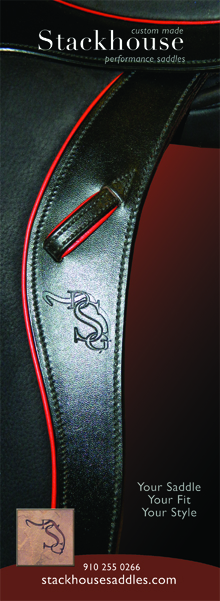Search the Site
The Fringe Eventer Blog Post # 12: The Holy Grail of Saddle Shopping
I purchased my first saddle completely unsupervised. That is to say, I picked out a saddle from a sales catalog that I could afford and in a shade of brown that I was partial to. I was utterly clueless, and this became the first in a long line of saddles that I would own, and the rocky start of my saddle education.
To give you some perspective, over the years I have owned at least six dressage saddles by two different manufacturers. If you include my jump saddles, I have, at one time or another owned a total of ten saddles. No I am not a hoarder. Some purchases were to trade up, one was to replace a saddle that had been stolen, and others were simply because I needed a better fit for my horse. Along the way, I have also had the opportunity to ride in many other brands and styles, one of which was a very old (20 + years) Passier Baum. My trainer introduced me to her Baum (aka Old Faithful) several years ago after I had sold one saddle and was patiently waiting 6 weeks for my new saddle to be made.
And so, as the story of my life goes, I once again was in need of a saddle for my mare’s ever changing back and I found my bum back in Old Faithful. Seriously, this is getting old!
You know those moments in life when a task that was once difficult is suddenly easy and you have a true eureka moment? I mean, the skies opened up and everything became clear in the most unexpected of ways. Well, it happened to me. Spending more time riding in Old Faithful, I began to notice a huge difference in my ability to flow with the saddle. At times, I almost felt as though I was moving too much. As for my mare, she felt somehow “closer.” My lower leg not only felt more stable to me, but to those watching me from the ground, it was more stable and still. I had more freedom to place my leg where I wished, and my lower back swung and moved with every step. These changes left me pondering the true difference between the old style slicker than whale snot, minimalistic, hedonistically hard saddles that Kracken-esque trainers like mine prefer, and the new uber soft, deep seated Lazy Boy, knee rest saddles that are so common today.
So, I asked myself, “What is the difference?
Like a gilded knight on a kingly quest I set out to find the answers, to seek not only additional saddle knowledge, but to challenge both what I felt comfortable with and what every glistening catalog page was trying to sell me. Okay, maybe the start of my quest was a bit more like Monty Python’s Holy Grail. “Come Patsy!”
I pulled out several jump saddles, one of them my ancient Stubben (aka Stewie – see my previous post) and several different dressage saddles from the tack room at my barn and set about comparing them. I mean really comparing them, and here is what I found. The jump saddles, both new and ancient varied very little. Shallow seats, forward flaps, and small to medium size knee rolls. The dressage saddles, on the other hand were starkly different. In fact, Old Faithful more closely resembled the jump saddles. The modern-style dressage saddle stuck out like a spherical, moo moo clad granny shopping at Bergdorfs, over the top, plump in all the wrong places, and clearly out of place.
Intrigued, I now took my search inside to the internet where I spent quite some time, hours in fact, scouring cyberspace for a lead on a dressage saddle that looked more like Old Faithful, than the overly fluffed saddles of today. Needless to say, my search was fruitless, but if you feel the need to prove me wrong, go ahead and search the internet. I’ll wait.
-Insert Jeopardy game show musical montage-
Oh good, you’re back. I’m guessing you found pretty much the same thing I did. Very few saddle makers create dressage saddles that aren’t overstuffed or over-fluffed in some way or another. In fact, if you have never seen a side by side comparison of the old and the new you might not have realized just how different they truly are, especially since there are very few saddles like Old Faithful around anymore.
After reviewing saddles made by Amerigo, Fairfax, Selleria Equipe, Custom Saddlery, Schleese, Devoucoux and Black Country, to name a few I did manage to narrow the list of contenders down to one.
Yes, just one.
The Passier Freemove Dynamic was the only saddle I saw that made the cut. It was also the most similar to Old Faithful. The honorable mention went to the Stubben D Genesis Special. While this saddle does not have a knee block, it appeared, in the images I saw, to have a slightly deeper seat so I decided not to include it. However, I might change my mind one day if I get the opportunity to actually sit in one. The D Genesis Special was modeled on the Schultheis Tristan Extra and Catherine Haddad Staller has a very good article on the merits of this classic saddle here http://www.chronofhorse.com/article/about-saddle-its-always-been-st%C3%BCbben. It is worth the read.
Now, the Passier Baum can be a hard saddle to find, especially in a medium tree so I broke down and ordered a Freemove from Europe to try. Truly I tell you, I am thoroughly tired of buying saddles and I’ve become convinced that this is my cross to bear as it relates to my equestrian pursuits. And, as Sir Galahad said, “...it is my duty as a knight to sample as much peril as I can.”
I’m bringing you along with me on my quest so be prepared to put your thinking cap on and answer some questions.
So, as the Bridgekeeper in my favorite movie sayeth, “Who would cross the Bridge of Death must answer me these questions three, ere the other side he see.”
-
What’s with the shallow seat?
-
Why are there no blocks, rolls, or fluff in general?
-
Do I make the leap and buy a saddle so different from what I’m used to?
So, what is with the shallow seat? - First I want you to think about how your hips move in the walk. The sitting trot. The extended trot. The canter. In each of these gaits the rider’s hips move differently to accommodate the movement of the horse. The sitting trot can almost feel side to side and forward to back at the same time while the canter rolls. Additionally, some horses have very exaggerated or bold gaits which would magnify these movements even more. Now ask yourself, “Does a saddle with extra fluff allow a rider’s hips to swing and move to the rhythm of each gait without ever blocking, stopping, or hindering the movement?” Is it possible that a deeper seat, while helpful during sitting trot, limit the swing of a rider’s hips in the canter? And what in the heck do they really mean by ‘deep seat’?
For me, I found that riding in both Old Faithful and the Freemove Dynamic were both freeing and challenging at the same time. My hips moved unhindered, held only in place by the core riding muscles I was meant to use. This same freedom was also disconcerting as my bum moved so much I felt a bit out of control at times. The old adage of keeping one cheek on either side of your horse’s spine in order to keep from slipping off was never more evident. This freedom I found was actually a good thing and once I let go and relaxed, allowing my hips and lower back to follow this newfound motion of my horse I discovered a more responsive horse. Freemove indeed!
Why the lack of leg fluff? - The blocks and rolls so prevalent on most dressage saddles are conspicuously absent on the older models and this got me thinking. Do those nifty knee rolls that riders rely on to keep their leg steady and in the ‘correct’ position actually block the natural movement of the thigh and therefore restrict the leg as a whole? Does a rider who has never experienced anything but fluff even know the difference?
This one was a real eye opener for me. The shoulder in movement is where I noticed the largest difference between the saddles. Honestly, I am still analyzing my most recent rides, but what I have deduced so far is that, whether due to the thin close contact feel of the flaps, or the freedom of my leg I am now able to “think” about shoulder in, weight my inside hip, apply a light leg aid and voila – success! Not only is there significantly less fluff between my leg and my horse, but without a knee roll I was forced to use more of my lower leg, which now draped nicely against my mare’s side. Apparently I had been gripping with my knee more than either my trainer or I realized.
My trainer instantly noticed the lightness, pointing out that now my aids were largely given from the weight of my seat bones as well as my inner calf – as they should be – rather than pushing my mare over with my whole leg as I had been doing before. Without spending time in the new Passier I don’t know if I would have realized just how disproportionate the use of my upper, rather than my lower leg had been.
For me, the freedom of my entire leg to follow the natural movement of my horse, stay put beneath me, or give a lighter aid is much easier and more natural. I mean, isn’t it a goal of dressage, the basis for all riding, to have light aides that are barely discernable to the naked eye?
Soapbox time: While I’m certainly not an upper level rider yet, I do know that riders who flail their legs forward and back during lead changes or tempi changes look ugly, and folks there is no need to look like a flailing cat. I am now wondering if a rider’s leg aid, limited by saddle fluff is exaggerated because of a lack of freedom? Watch a couple of upper level riders on YouTube and you’ll see what I mean. The aid for the lead change is often accompanied or perhaps given by a lower leg that swings much farther back than it should. The aid should be imperceptible and in order to accomplish this your leg needs to stay within a small sphere of influence, not swinging back towards their flank.
Do I take the leap? – I tend to order the same thing if I am eating at a restaurant that I have dined at before. It’s not because I’m unimaginative or afraid to try new things. Quite the contrary. I simply find something I like and stick with it. I’m faithful like that.
So the thought of purchasing a completely different saddle after only trying it for a week was daunting. In the end I decided to take the leap and see where this change takes me. I figured since I couldn’t find a Baum I would buy the Freemove Dynamic since it most closely – and I mean closely – resembled the Baum.
As it turns out and quite by accident, while oiling my saddle, I noticed that the very inside of the sweat flap is stamped ‘Baum’. Who knew? I’m thinking that Passier has tried to market the Baum under a newer, snazzier name in hopes of selling more. Personally I think this is one dumb move, especially since the name Baum is still sought after by many classically trained riders.
All padded up. This is before I had the saddle checked for fit and had committed to purchase it.
As a new saddle, and since Passier does not offer demo saddles, I had to channel my inner witch
with this classy display of tights to cover my stirrups. (Insert evil cackle)
Now, I’ve always been a true believer in a traditional wool flocked saddle, and after seeing just what came out of my new saddle I’m even more convinced of the benefits of natural wool flocking. I’m a bit flabbergasted that a brand such as Passier would even consider synthetic flocking, but alas all of their new saddles are full of it. I ended up having my saddle completely re-flocked with a high quality New Zealand wool.
This is what came out of my saddle. Notice the lumps and bumps. It was not unlike the stuffing in a child’s stuffed toy.
Disclaimer – No, I’m not advocating that everyone go out and buy this saddle. No, this saddle may not work for you. My point was to share my experience and make you question your fluffy saddle and how it may impact your riding.






